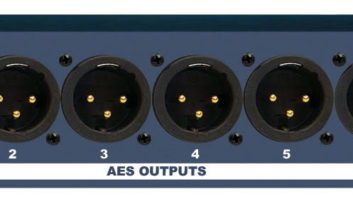(click thumbnail)Audion’s VoxPro 4.0 audio editing system turned my PC into a responsive cut-and-paste editor with the ability to instantly recall and play different audio cuts – and initiate record just as quickly.
Underneath the sleek application’s skin lies a cornucopia of user-friendly audio tools that allow a jock or production staffer to share and administer files, add compression and limiting to recordings and add reverb, compression, EQ, echo and special effects to their playback audio.
Positioned to be the tool-of-choice for recording and processing incoming listener phone calls while the busy jock sets up the next set, VoxPro is even an agreeable music editor.
At $999 MSRP (upgrade from v3.0 or higher for $159), VoxPro 4.0 will take the place of a number of different audio tools. Coupled with the VoxPro USB control panel from JLCooper ($999 list), the application becomes fast and functional.
Editor’s choice
The heart of VoxPro is its ability quickly to import audio formats of your choosing, and make them available for non-destructive editing. It also can manage the preferences of various users and allocate virtual “partitions” for their audio files, protecting the afternoon jock’s materials from the morning team’s audio for instance.
If a station has multiple copies of VoxPro running on networked computers, one can swap files (if permissions are set) over the LAN. VoxPro handles locating other instances of itself and managing the file permissions, so the user doesn’t have to poke around the network or remember arcane Uniform Naming Conventions.
VoxPro offers full audio control, from rapid shuttling to reverse and forward scrubbing at normal or half speed, and help in finding the right spot for placing an edit marker. Pressing the Zoom button on the hardware control panel, or “Q” on the keyboard, zooms to a 100x waveform for tight editing.
Drop-in markers with editable text descriptions allow the user to identify important locations in the file, and can be placed in either Play or Record. VoxPro uses the “stationary play head” convention, but the user can choose in which “direction” the audio flows past the play head: from left to right (typical) or right to left.
The large VU meters respond fast during playback and recording, and the application’s skin is an attractive clean metallic finish that is pleasing and unobtrusive.
I installed the VoxPro 4.0 software on an ordinary Dell OptiPlexGX270, Win2K, with 512 MB RAM, and an integral SoundMax sound card and a legacy Digigram PCX11 sound card. I plugged in the USB dongle to activate the software, and plugged in the RC-500 control panel into another USB port.
The RC-500 is powered by the USB supply, and has a pleasing backlit LCD display for quickly recalling user-selected cuts and a solid reliable feel. Its jog wheel has the right weight, and transport controls are within a hand’s reach.
I had to choose the “Use Legacy WaveAudio drivers” to enable VoxPro to use my obsolete PCX11. But I was pleasantly surprised to find it worked well in Record and Play. I immediately tried to use VoxPro’s integral CD Ripper, but found it wouldn’t advance past an ASPI error message. Audion tech support told me there is a software error in the current version that prevents the ripper from starting, so I ripped a music CD using the freeware application CDex to prepare some WAV files for VoxPro.
The import into VoxPro was a few seconds per cut and was completed quickly. The inventory panel showed each cut’s name, length, created and modified date stamps, file size and format. I could have set up an import directory for VoxPro to import the files automatically, too.
Product CapsuleTHUMBS UP:
Speed
Quickly imports audio formats
Variety of audio tools/effects
Responsive VU meters
THUMBS DOWN:
Software error prevents CD Ripper from starting
BWF files stall in the import process
PRICE: $999 MSRP
CONTACT: Audion Laboratories in Washington state at (206) 842-5202 or visit www.audionlabs.com
While audio files with embedded tags import easily, Broadcast Wave Files stall in the import process. In my evaluation I was using MP2/384 kbps/48 kHz BWF files. My workaround was to convert the BWF files to plain MP2 at the same bitrate and sample rate by using a converter like dBPowerAmp.
Making music
Even though VoxPro is positioned as a voice editor, I wanted to exercise it by cutting music, which is arguably more demanding and certainly more fun. VoxPro turned out to be capable for simple music editing; the cuts are butt-edits, not crossfades but the result is great for making quick and easy music beds.
When the waveform Zoom is engaged, I had trouble using the RC-500 control panel jog wheel to nudge the waveform accurately, but found repeatedly pressing the Scrub Slow Forward (or Backward) button worked much better. In everyday use, you’d probably not be faced with these extra fine trims, but it’s nice to know VoxPro will work with you if you need that resolution.
Asked for comment, Audion CEO and founder Charlie Brown told Radio World, “In all fairness the reason the jog wheel responded the way it did is because, as he says, his sound card would only work with the Use Legacy Wave Audio Drivers option checked which, as stated in the option window, is not recommended. The reason we don’t recommend this option is because of the exact results Rich experienced.”
When it came time to record, I engaged VoxPro’s Automatic Gain Control and pressed the Record button – again the VoxPro starts Recording immediately with no delay or latency – but I found I couldn’t listen to the processed signal while recording. After some experimentation, it became apparent why the AGC feature can be disabled: it is powerful enough to be misused.
The AGC can be applied to one or both input channels, and I found the factory default settings to be most appropriate for most instances, especially when you cannot hear the results until after the recording. By setting the AGC to the most extreme settings, you can simulate the pumping of a pair of back-to-back UREI compressors. Caution, though; you’ll want to lower your input level when you set extremes. My “extreme” recordings were quite hot, so the AGC is pleasing to play with but naughty to misuse.
If your computer is used for other tasks while VoxPro is running, it’s nice to know the RC-500 control panel buttons operate VoxPro even if the application doesn’t have “focus.” It’s also worth knowing that in Play or Record, menu items are inaccessible. If you want to adjust the AGC or browse the application’s Help file, or call up the audio level panels from within VoxPro, you must open the menu items before you record or play.
Once you have audio material within VoxPro’s realm, you can apply any number of useful effects to the selected audio, and undo them as easily as pressing CTRL-Z. Standard effects include echo; reverb; reverse; adjust pitch, tempo, rate or level; and insert a bleep or silence.
VoxPro also incorporates Microsoft DirectX Media Objects for advanced effects such as a simple and effective parametric EQ, Interactive 3D Audio Level 2 reverberation effects with presets, distortion, flanger, compressor and other treats. I easily made a Poltergeist-type effect by selecting some spoken words, clicked Reverse, then clicked Reverb (adjusting for taste) and then clicked Reverse again. Voilà! Spooky reverse reverb with just a few mouse clicks.
Version 4.0 gives users some new features, compared to previous issues, including AGC with the ability to compress or expand the caller’s channel or the talent’s or both, with settings control through the admin account. The new peak program VU meter with accuracy to -72 dB is a nice companion feature.
Auto-Network allows engineers to network VoxPro machines without setup or configuration. In fact, the only configuration required is if you do not want the VoxPro workstation to have network access, or if you want to restrict access to only a few other VoxPro workstations. The VoxPro network allows any user to log in to his/her personal account from a VoxPro workstation on the LAN, and access (play/edit/record) files from that workstation.
Other new features include Auto-Import, which imports media files that appear in a folder specified by the user; EZ-Export, which allows users to export files to a particular folder in a particular format; Markers; improved effects such as time stretching and pitch shifting; and normalization, in case you forget to turn on AGC.
The company also says it abandoned the proprietary file format used in VoxPro 3.0 in favor of the standard WAV file format. This means higher fault tolerance, as there’s only one file to open instead of an edit file that references a master file. Incorporating all file information into one RIFF WAV file gives VoxPro more stability.
VoxPro is a tight software package, incorporating some great software libraries under the GNU Lesser General Public License and enhanced with audio effects from Microsoft’s DMO, but its real strength is its speed and responsiveness on even a plain PC; and as a plus, it’s an attractive performer in the studio.













